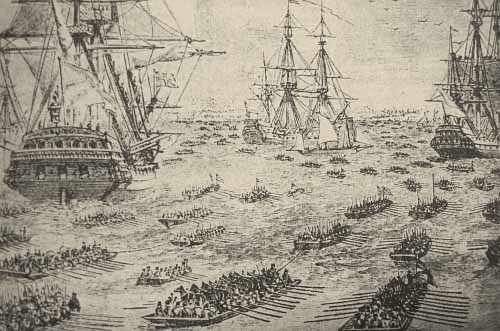The Naval Advantage in 1776
This past week has been the anniversary of the British landing on Long Island and the battle of the same name. As most readers of this blog know, the invasion and the events following it provide the background for my novel,
The Patriot Spy. I thought I would use this blog to discuss the role of naval power in the campaign. The American Army under General George Washington had essentially no knowledge of the British intentions after General William Howe withdrew his besieged army from Boston. However, it did not take a stretch of genius to know what the overriding British advantage was in the war: the Royal Navy.
 |
| 1776: British fleet at Staten Island |
Early success, defeat and triumphs
 |
| Destruction of the Spanish Armada |
In some ways, the story of Britain is the story of its navy. During the time of the Yankee Doodle Spies, Britain had the greatest navy in the world and, more importantly, had over a century of knowledge and experience in knowing how to effectively use that advantage decisively. Many are familiar with the victories of the 16th-century English navy under Elizabeth I against the Spanish. But during the 17th century, England and its navy went through a time of upheaval. The English Civil War, three wars with the Dutch (who had eclipsed Spain as the world's dominant mercantile and naval power), and the "Glorious Revolution" had impacts on the navy's development, both positive and negative. During that time, the English and Scottish fleets merged but, on paper, were still separate. The Dutch Wars first favored the Dutch, who won remarkable naval victories. Still, Britain gained the critical Dutch colony of New Amsterdam (1664), and it learned how to develop its navy through the experience of defeat. By 1692, the British had the finest fleet in the world. The political accommodation with the Dutch, which declared their ruler, William of Orange, as William III of England, strengthened both navies. In a curious alliance, the Dutch fleet sailed under British admirals in the subsequent wars with France and Spain that dominated the close of the 17th and most of the 18th century. The British were able to expand operations globally and in a series of wars, picked off colonial possessions, large and small, to build a support structure for its naval and mercantile needs.
.jpg/1024px-Het_verbranden_van_de_Engelse_vloot_voor_Chatham_-_The_Dutch_burn_down_the_English_fleet_before_Chatham_-_June_20_1667_(Peter_van_de_Velde).jpg) |
| Dutch burn the British fleet at Chatham |
Britannia rules the waves!
 |
| Royal Navy in Action |
The Royal Navy of 1776 had a swagger built on achievement. Part of that achievement included what would later be called "combined arms" actions. That is the use of Royal Marines for small sea-land actions and cooperation with the Royal Army for major actions, mostly transporting forces and protecting the supply lanes of those forces. This was developed during the Seven Years' War (French and Indian) in North America. With the onset of the rebellion, the Royal Navy was Britain's biggest advantage over the rebellious string of coastal settlements poorly connected by a handful of bad roads. America relied on the sea, and control of it was central to any strategy to suppress the colonies. Trade could be cut off, starving the rebellious colonies relying on the mother country for many finished goods. That this policy was one of the grievances leading to rebellion is ironic. Britain's decisive edge at sea was a factor in some Loyalists' sympathies or at least antipathy to the cause of rebellion. To many, it appeared insane to take on the greatest global (read naval) power the world had ever seen. Those concerns were well-founded during most of the war. America had no navy in comparison and was urgently building a semblance of one more as a show of national pride than to gain strategic advantage. In fact, the American advantage at sea was its force of privateers, many from merchant vessels re-purposed because of British control of the seas - another irony. The effective use of naval superiority got Howe out of a tactical trap in Boston. It enabled him to effect a well-executed envelopment from the sea and sweep into New York harbor, changing the venue and tempo of the war to Britain's advantage.
Invasion, they're coming!
 |
British landing at Gravesend on Long Island
(near the site of Brooklyn's Verazano Bridge) |
The Royal Navy isolated New York from the sea and rendered its port useless. The port gave the city its strategic importance as New York in the 18th century was not the largest American city. The Royal Navy provided reconnaissance, naval gunfire, and transport for a succession of landings at Staten Island, Gravesend, Kips Bay, and Westchester (Throgs Neck, Pelham, etc). British naval movements confused the Americans and threatened areas. General Howe had no intention of attacking. As importantly, it restricted General Washington's ability to move troops and forced him to try to defend more land than he had soldiers and guns to cover. Surprise, maneuver, and firepower are critical multipliers in any conflict, but they are even nicer when you have overwhelming forces as well!
As discussed in The Patriot Spy, only extremely unfavorable winds and tides prevented the other Howe (Admiral Sir Richard, William's brother, and naval force commander) from enveloping Washington's forces on Long Island, who huddled in a desperate defensive position on Brooklyn Heights. Had the conditions been right, Howe's fleet could have bombarded Washington from the rear and coupled with the army besieging Washington's front, forced surrender in the summer of 1776. Would the loss of George Washington and a large chunk of the Continental Army have ended the war then and there to Britain's advantage? Well, that's the subject of another blog.


.jpg/1024px-Het_verbranden_van_de_Engelse_vloot_voor_Chatham_-_The_Dutch_burn_down_the_English_fleet_before_Chatham_-_June_20_1667_(Peter_van_de_Velde).jpg)


Those landing barges look remarkably like Higgins boats!
ReplyDelete